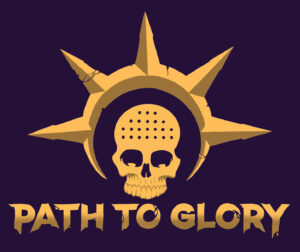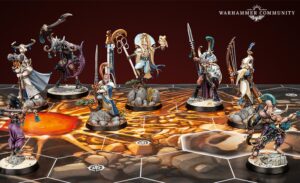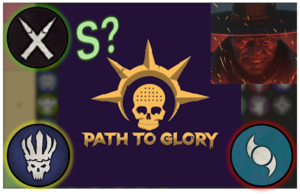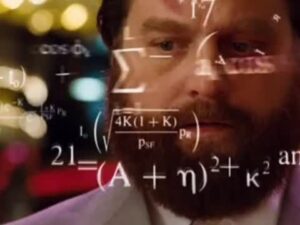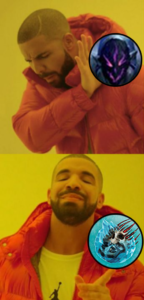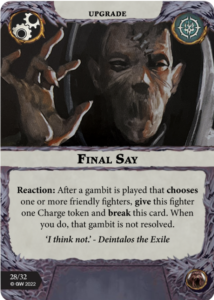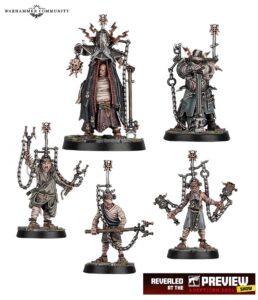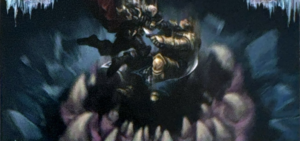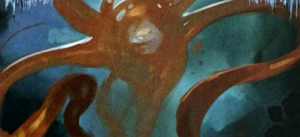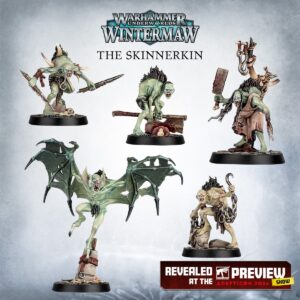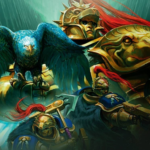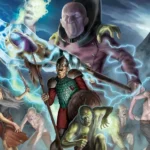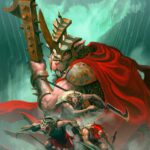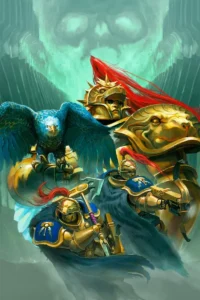Hello Gloryseekers,
Jonathan here, talking about the rules, mechanics, themes and ways to play in Harrowdeep, the 5th season of Warhammer Underworlds. Games Workshop was kind enough to send me a copy of the Harrowdeep set to review, so I hope you enjoy this review!

_________________________
Seasonal Themes
Like previous rulebooks, the rulebook for Warhammer Underworlds: Harrowdeep contains a lot of information on the lore of the game. This season, the cursed adventurers enter the shadowy realm of Ulgu, in the underwater halls of Harrowdeep, a magical shadow labyrinth where the warbands fight for glory, treasure, or a way to escape. The Katophrane curse is broken, but the warband still fight on in the shadows.
The overall themes of the season are shadow, gloom, illusion, and paranoia, and the rules and art for season reflect really reflect this. Overall I think this is the season with the coolest color scheme and art so far though I’m not sure I like the idea of the Katophrane curse going away, as it was one of the coolest parts of the lore for me.
_________________________
Seasonal Rule Additions and Changes
Games Workshop has been tweaking and polishing the rules of Warhammer Underworld’s since it’s release, and this season is no exception! In fact, this may be the season with the most changes ever!
_________________________
Grand Alliance Symbols – Pages 17 and 19
This season’s rule additions begin with some Objective, and Power cards, and all new Fighter cards now having one of 4 “Grand Alliance” symbols. These symbols add a new layer of deck building to the game in the championship format, because similar to faction cards, warbands can only include grand alliance cards in their decks if they match their warband symbol (or, for older warbands, if they are on the list).
I talk about the specific cards more in my Universal Card Review, but I think this is a neat twist to deck building this season, and in theory, can allow the designers to create powerful cards knowing they will not be available to specific warbands (Hrothgorn, Mollog, etc), and create flavorful lore based effects for each Grand Alliance. A possible downside might be that this means there are fewer cards available to each warbands (since they can each only use 1/4 of the cards) but as always the design of the cards will have the largest meta impact.
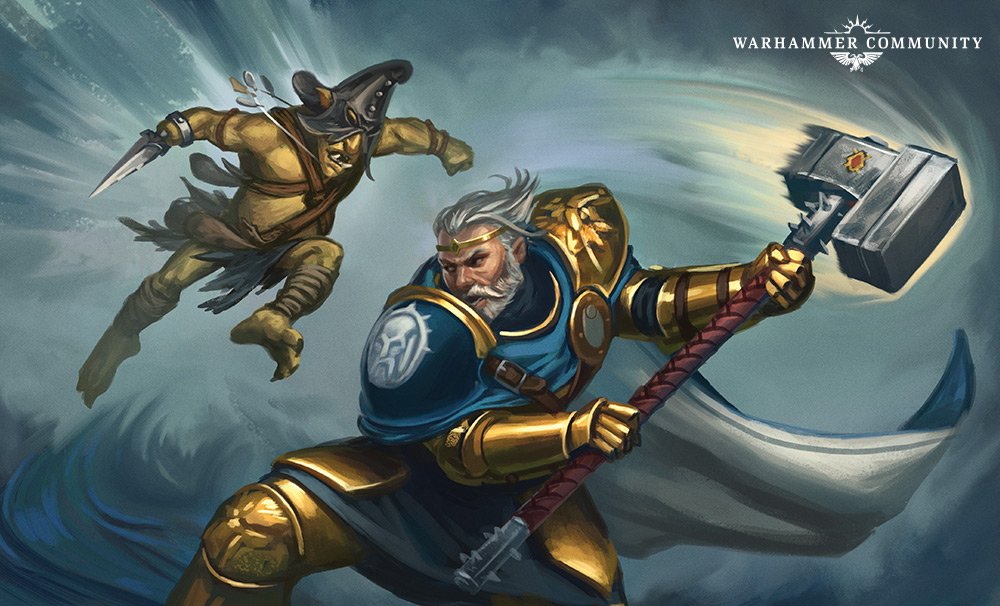
_________________________
Traits – Page 18
More of a rules standardization than a core change, the game now has a list of traits for things we’ve seen before on fighter cards: Beast, Flying, Leader, and Wizard. The rules for these symbols are now included in symbols on the fighter cards, which seems like a nice way to save space and ink.
_________________________
Deck Building – Page 19
In an interesting twist I never would have expected, the rules now allow you take any number of objective cards in your decks, though there is still a limit of 6 surges. This is…interesting. In general, I think you will still want to stick to 12 objectives and 6 surges because this tends to lead to a smoother deck, I guess there might be some situations where you would prefer to have more overall glory, or not have to choose between those two last end phase cards. Taking more cards also reduces the chance of getting your 3rd end phase card in the first round…but I’m still not sure if it’s worth doing.
_________________________
Cover Hexes – Page 23
Goodbye Lethal hexes, hello Cover hexes! As a lifelong (okay, like two years) hater of lethal hexes, I am excited to see how the player placed (and built into some boards) Cover hexes effect the game.
My initial thought is that they won’t do a lot on their own, though they do make dodge fighters a lot harder to hit, but I think we will notice the lack of lethals, and perhaps get some some cool card interactions to go with them.
_________________________
Board and Objective Placement – Pages 24 and 26
First off, the diagonal board placement rules from Direchasm are now in the rulebook: you must connect at least 4 hexes when you set up the board the long way. I think this rule was generally well received, so it makes sense that it is now in the core rules.
A much bigger change, the way Feature Tokens can be placed has now changed. Now, you are not able to place the last objective token on an edge hex unless you cannot place it anywhere else. In general, this forces the objectives to be more in the center of the board, and makes having 3 objectives somewhat less important. As a player that enjoys putting some thought into objective placement strategies, but also sees how the previous system could be somewhat punishing, I think time will tell if this is an improvement. Generally, this and the last year’s board placement rules changes have acted to smooth out the up and downsides of who gets boards and objectives which I think is interesting, though I do think this change makes having board setup the obvious choice in most situations.
_________________________
Gloom and Delve – Pages 26 and 36
Speaking of changes to feature tokens, the feature tokens in Harrowdeep now start objective side down, and Gloom side up. Gloom hexes are basically cover hexes, giving defensive support to those in them.
Feature tokens can also now be Delved (flipped) in the power step by players with a fighter in them instead of playing a card. Honestly, I’m not really a fan of this. I think it’s interesting that you can sort of stall playing your power cards in the power step, I have never really thought flipping objectives worked well in this game, as it is actually a lot of work to do physically while playing the game. It’s true that you can only flip each token once per power step…but that is still quite a lot of flipping since you basically want all of your feature tokens to be gloom in your opponent’s turn (so you have the supports) and objectives in your turn or at the end of the round, depending on what cards and effects you have.
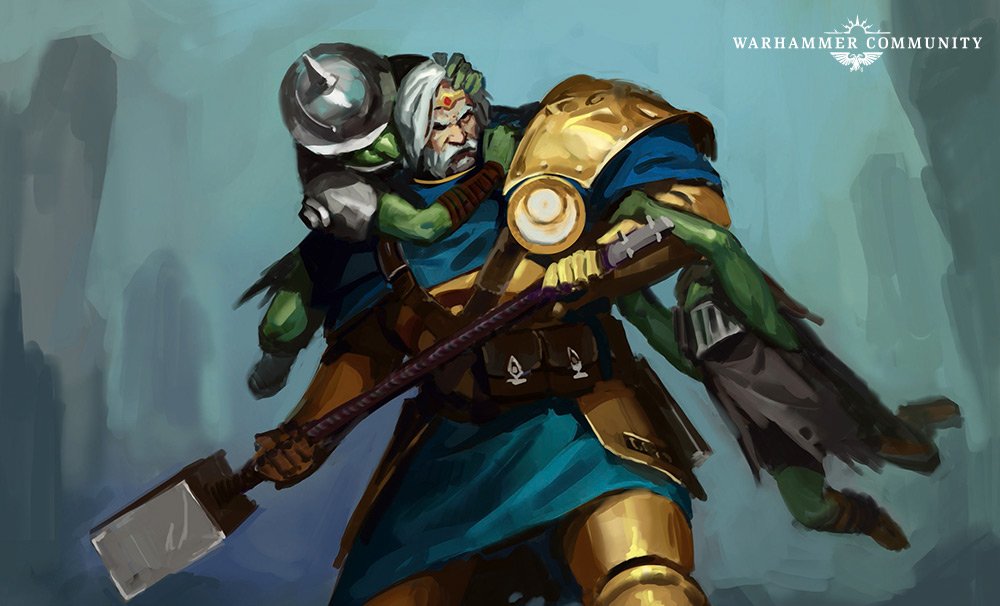
_________________________
Do-Over Changes – Page 27
Another simple but big change in my opinion is the change to the doo-over (mulligan) rules. Now, instead of throwing away your first hand of objective or power cards for good, you must now shuffle them back into your deck after drawing their replacements.
This change does a few things. First, it allows for more daring deck building with objective cards like third end phase cards, or power card combos like tomes, since if you do draw them too early or all at once, you are able to replace the hand without losing out on a huge portion of your glory/win condition/combo ability.
Secondly, it makes pretty much all objective and power decks smoother, since you can aggressively do-over any hand you don’t like with pretty much no downside, and still get to use all of your cards over the course of the game.
Finally, it also reduces some of the power of some decks after a do-over, such as in situations where you draw 5 upgrades or end phase, throw them out, and then get to play the rest of the game with 66% gambits or surges, which is stronger in some ways, though usually not as powerful over the long term of the game. Now, you get some of the bonus (since the cards you are drawing from don’t have the cards you just discarded in them) but still have to play the game with your whole deck for better or worse.
_________________________
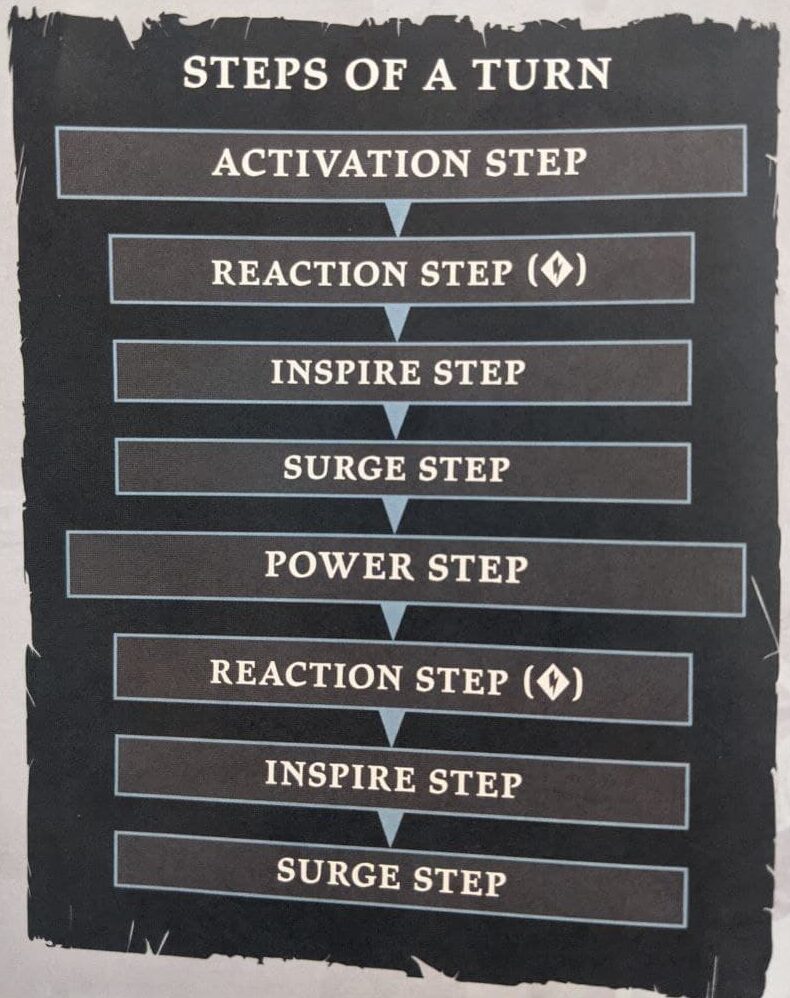
Inspire Steps – Pages 18 and 28
There now a point in the called an Inspire step, which is a fairly big change to how warbands inspire. There are now two point in the game when a fighter can inspire: After an activation and after a power step. If you meet your condition at any other time, you have to wait for the next Inspire step to inspire that fighter. For warbands that inspire by doing something in an activation or power step (Reavers, Steelheart’s, Ironskull’s Boys, Sep Guard, Magore’s, Cursebreaker’s, Eyes, Gitz, Mollog, Godsworn, Ylthari’s, Harrows, Condemners, Despoilers, Rippa’s, Wurmspat, Hrothgorn, Krushas, Dread Pageant, Purifiers, Lizards, Reapers, Stormies, Skaven) this ends up being pretty much the same except that the whole power step has to end first.
For those that inspire before an activation (Thorns, Wraithcreepers) or in an end phase (Farstriders, Chosen Axes, Thorns, Wild Hunt, Grymwatch, Vampires, Soulraid) now seem to have to wait for the power step after the next activation, which is a pretty large change for them, though perhaps not an unwelcome one, unless these inspired rules count as “But My Card Says” rules on page 21 (which would require an FAQ, I think).
It does seem like Profiteers, Blade-coven, and Madmob probably get to avoid this rule since they do not have normal inspire conditions (or in the case of the Blade-coven, have a 2nd way to inspire).
Finally, the after activation inspire step is also AFTER the reaction step, which is a slight nerf to warbands that were able to activate, inspire, and then react with inspired stats (Harrow’s with Echoing Spite, etc).
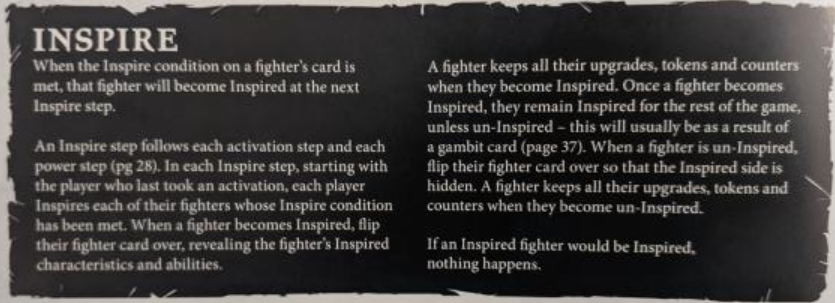
_________________________
Broken Upgrades – Page 27
A small addition, there is now a name for when you force discard an equipped object – Broken.
_________________________
Power Step and Timing Changes – Pages 36
In another fairly large change, the order that players play power cards in the power step has now changed! Now, the player who did not activate now has the first chance to play a card, instead of the player that just activated in the previous seasons.
This would have been a bigger deal in previous seasons with more lethal hexes, but is still a fairly big deal, as it means players have a chance to play a Wound upgrade, push card, or other power cards to help them avoid power plays like a push into a lethal hex, ping damage cards, and so on.
_________________________
Reaction Steps – Pages 28 and 40
Reaction steps don’t really change a lot, but man are the rules a lot clearer than they used to be. I am pretty sure that this is how I thought reactions worked, but it’s nice to have it as spelled out as it is.
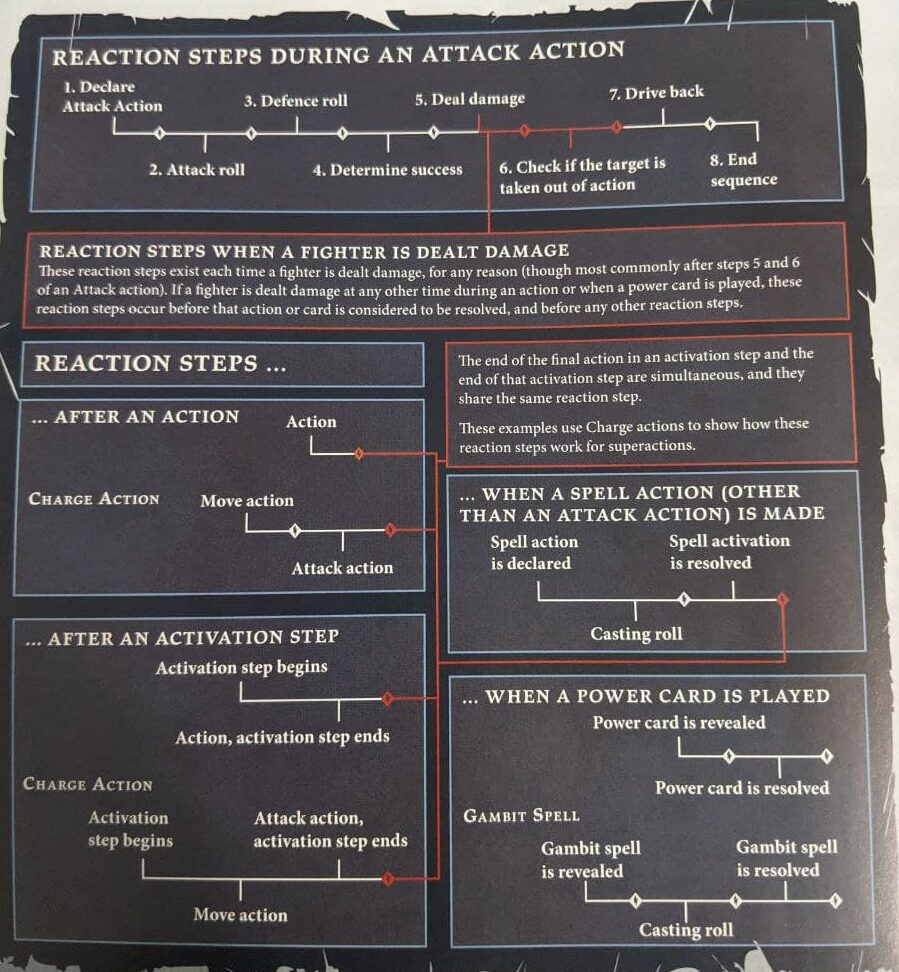
_________________________
Vulnerable – Page 33
Vulnerable is basically just a fancy name for “will die if you get one more wound” and doesn’t do anything on it’s own. Cards can refer to it now, though.
_________________________
Grievous – Page 34
Grievous is a few keyword similar to Cleave and Ensnare that may show up on attack actions or power cards, and does +1 damage if the attack is a critical hit. I think about this effect as “+1 dmg half the time” since something like half the time you hit an attack, you crit. This is a nice effect to have on any attack action, and gets better the more dice you have. If you got to choose, you would prefer to have this on 3 fury attacks over 2 smash attacks, and of course you would always just prefer a flat +1 damage if given the choice.
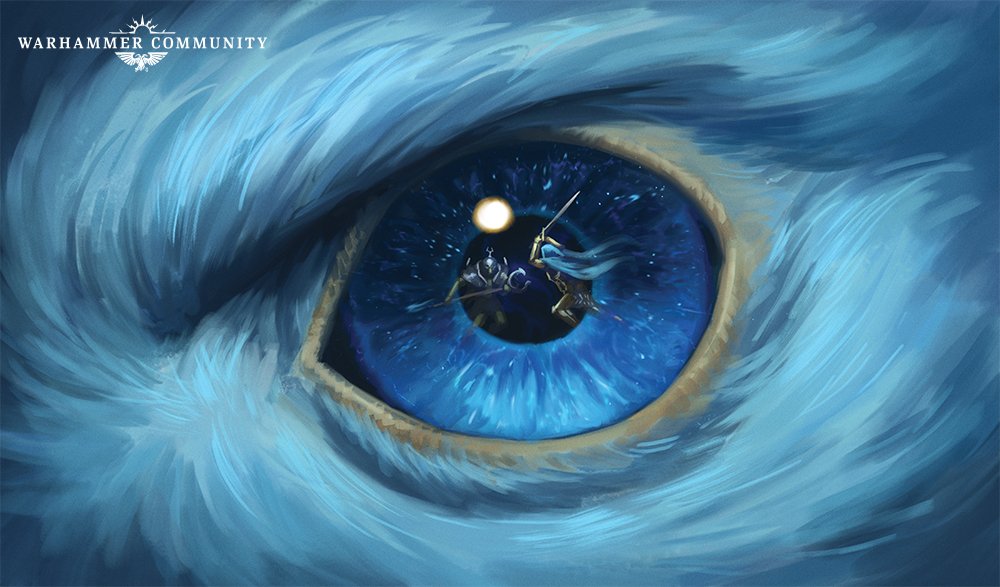
_________________________
Stagger – Page 34
Stagger is a new rule that finally gives you a reason to carry around more than one guard token! Stagger is a rule that can be on attack actions similar to Cleave or Ensnare, and fighters can be staggered by cards as well. Once staggered, a fighter loses any guard tokens they might have, and enemy attacks get to re-roll one dice against them. This effect stays on the fighter as long as they have the Stagger token, which is until the end of the round, or the next time they get a Guard token.
I think this is a solid effect to have built in on an attack action, and might even be worth taking power cards for. The re-roll is decent on it’s own, and if you are able to also remove a guard token then it does make a big difference in the attack action math.
_________________________
Surge Steps – Pages 28 and 40
Similar to Inspire and Reaction Steps, we also now have steps for Surges after each Activation and Power Step. This means you cannot score and redraw surges in the End Phase anymore, though you do now reveal the card as soon as you meet the conditions, which is a little different. Overall I think this is a cleaner way for things to work, with fairly minimal actual in game effect, unless you were doing a lot of scoring in the power step.
_________________________
Illusion Upgrades – Various Cards
These are a new type upgrade cards that cost no glory, but go away at the end of the round, when the fighter is chosen by a gambit, or the fighter takes damage.
_________________________
Brawlers and Assassins – Various Cards
Harrowdeep has also added two new fighter traits to the cards of this season. Similar to Hunter/Quarry from the Beastgrave and Direchasm Seasons, these traits do nothing on their own, but are referenced by cards. Unlike Hunter and Quarry, they do not seem to be connected to each other in any way (and hopefully they are more functional that H/Q!).
I talk about the cards that we have seen so far in my Universal Card Review, but it should be interesting to see what these mechanics have in store for us in the season.
_________________________
Seasonal Mechanics
So far, the mechanics of the season appear to be a bit milder than those of Direchasm (Primacy and Hunger), and center mostly around the new Gloom tokens, the new Assassin and Brawler keywords, Grand Alliance cards being a thing, Illusion upgrades, and small effects like Stagger and Grievous. This seems fine to me for all of the format, as Primacy is still going to be a big deal in Championship/Alliance, and the other formats are more beginner friendly anyway.
At first take, I can’t say I’m really a big fan of Gloom or Illusion. Gloom tokens and Delve seem interesting in theory, but I can’t help but think that it’s going to be a lot of bother flipping tokens back and forth so many times each game if you want to make the most of objectives. I am happy the lethals are gone, though!
Illusion upgrades seem to somewhat defeat the purpose of upgrades (long lasting cards that cost glory to use), so I wonder how it will effect the balance of things. A lot will depend on the quality of the Illusion cards that are released, but for the most part you really only care if you get to keep an upgrade’s effect the activate that you play it, and I can’t see it being worthwhile very often for your opponent to play a power card to remove it (trading a gambit for an upgrade). On the flip side, if you take too many of them, their upside (being free) stops mattering much as you gain glory, and their downsides probably start being more noticeable, so it will be interesting to see their use as the season progresses.
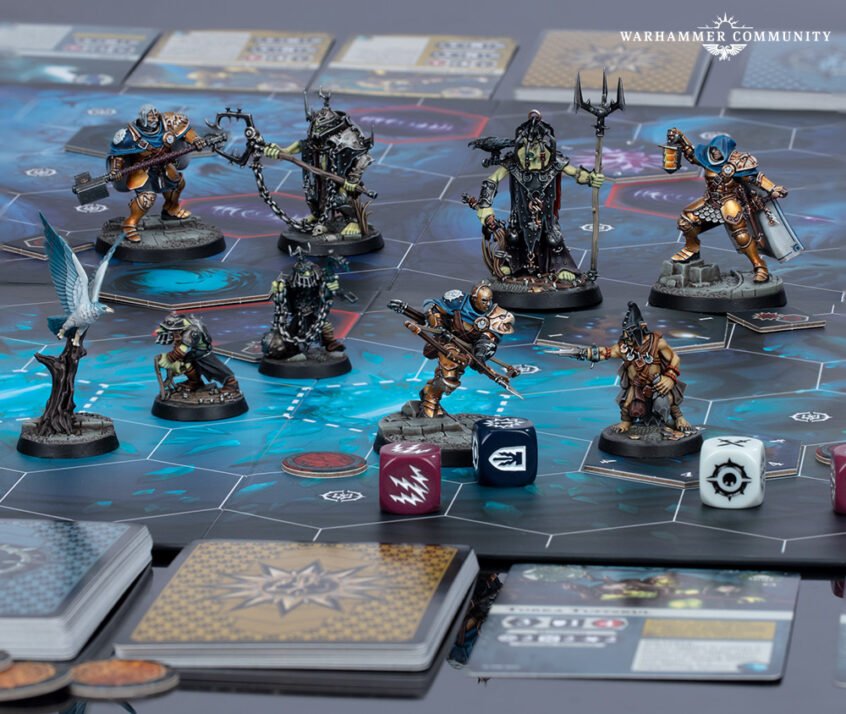
_________________________
Meta Thoughts
It’s always hard to know what a meta will be like at the start of a season. With new warbands, cards, mechanics, and rules entering the game, and other cards, mechanics, and rules leaving, the complex meta math of what strategy ends up with the most glory at the end of the game vs the other strategies is so complex that all you can really do is speculate.
At first glance, it seems like this may not be a season of objective dominance. With the changes to feature tokens and most of the strong hold objective surge cards cycling out with Beastgrave, objective play looks as if it will be more reminiscent of Shadespire or Nightvault, with a stronger focus on holding objectives in the end phase with cards like Dominant Position (which actually got a lot easier with Gloom tokens not counting against it), Path to Victory, and maybe even Supremacy (which may also be easier with Distraction, Nightmare in the Shadows, Restless Prize, and Mischievous Spirits rotating, and Cover hexes to hide in), and all of the surges will feel a lot more like those in the Storm of Celestus Warband until you get those tokens flipped. In general I think this style of objective play is a lot more tactical and interesting than the madness of Beastgrave era Grymwatch style surge objective holding, but how viable it is competitively will be against the Direchasm -fueled primacy aggro fest warbands, or whatever style of control play rears it’s head (or hides in the corner) this season will remain to be seen.
My personal preference would be for aggro to very viable, perhaps even the norm, with objective and control play being playable but requiring a bit more skill and attention to do well with. I think this balance, if possible, would result in a meta that is both tactical and interactive, while fulfilling the game’s promise of being a competitive area combat game.
_________________________
Final Thoughts
If you got this far, thanks for reading! The Harrowdeep season looks like it will be a very interesting one from a design perspective, and I know I am looking forward to playing lots of games over the next year (perhaps even against some of you if there are any events).
Jonathan
